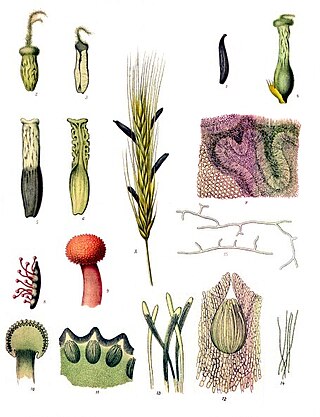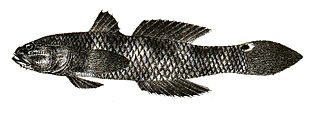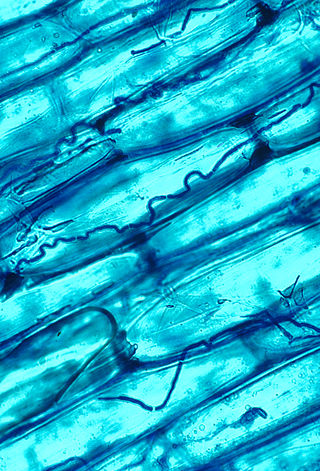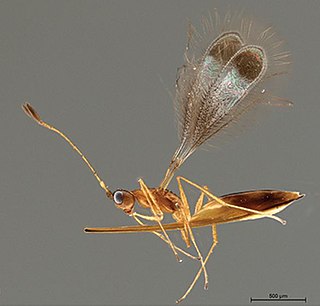In recreational mathematics, a polystick is a polyform with a line segment as the basic shape. A polystick is a connected set of segments in a regular grid. A square polystick is a connected subset of a regular square grid. A triangular polystick is a connected subset of a regular triangular grid. Polysticks are classified according to how many line segments they contain.

The Clavicipitaceae are a family of fungi within the order Hypocreales. A 2008 estimate placed 43 genera in the family, but a study in 2020 has increased this number to 50.

Ricinoleic acid, formally called 12-hydroxy-9-cis-octadecenoic acid, is a fatty acid. It is an unsaturated omega-9 fatty acid and a hydroxy acid. It is a major component of the seed oil obtained from the seeds of castor plant, the plant that produces ricin. It is also found in the sclerotium of ergot. About 90% of the fatty acid content in castor oil is the ricinolein.

The buffalo treehopper is a species of treehopper belonging to the subfamily Smiliinae. It is sometimes classified as Ceresa bisonia.
Cavimalum is a genus of fungi within the Clavicipitaceae family.
Heteroepichloë is a genus of fungi within the Clavicipitaceae family.

Lecanicillium lecanii is now an approved name of an entomopathogenic fungus species, that was previously widely known as Verticillium lecanii (Zimmerman) Viegas), but is now understood to be an anamorphic form in the Cordyceps group of genera in the Clavicipitaceae. Isolates formerly classified as V. lecanii could be L. attenuatum, L. lecanii, L. longisporum, L. muscarium or L. nodulosum. For example, several recent papers, such as Kouvelis et al. who carried out mitochondrial DNA studies, refer to the name L. muscarium.
Romanoa is the generic name of two groups of organisms, and may refer to:

Parachaeturichthys is a genus of gobies native to deep waters of the Indian Ocean and the western Pacific Ocean.

Balansiae is a tribe of fungi in the family Clavicipitaceae, described in 1950. It contains endophytic fungi symbiotic with grasses and sedges.

Polynema is a genus of fairyflies or fairy wasps, insects in the family Mymaridae.
Polynema howardii is a species of fairyflies or fairy wasps, insects in the family Mymaridae. It has a Nearctic distribution.
Metarhizium rileyi is a species of entomopathogenic fungus in the family Clavicipitaceae. This species is known to infect Lepidoptera, including economically important insects in the Noctuoidea and Bombycoidea; there is an extensive literature on this fungus under its synonym Nomuraea rileyi.
Cirrholovenia is a genus of cnidarians belonging to the family Cirrholoveniidae.
Periglandula are a genus of fungi in the family Clavicipitaceae. They live as epibionts, in a symbiotic relationship with two species of plant, Ipomoea asarifolia and Ipomoea corymbosa. They are known to produce ergot alkaloids related to lysergic acid.
Periglandula ipomoeae is a fungus of the genus Periglandula in the family Clavicipitaceae. It lives symbiotically with the plant Ipomoea asarifolia as an epibiont.
Polynema euchariforme is a species of fairyfly.
Polynema striaticorne is a species of fairyfly. It parasitizes the eggs of the Buffalo treehopper.






